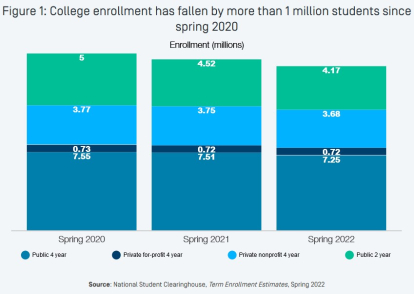University enrollment plummets: one million less than two years ago
Young people believe that the benefits of obtaining a degree do not outweigh the high cost of tuition and time spent studying.

(Pexels)
University enrollment data has revealed that fewer and fewer high school graduates are deciding to enroll in university. In 2020, 63% of high school graduates were enrolling in college programs, however, in 2016 that percentage was nearly 70%, according to a report by the National Center for Education Statistics (NCES).
2020 saw the lowest percentage of enrollments in 10 years. The downward trend has continued into 2022: according to the National Student Clearinghouse, there were one million more enrollments in 2020 than in 2021.

Skepticism
The price of a four-year college degree keeps rising and the time required to finish a degree is getting longer and longer. This has caused many young people to question whether college is really worth it. A report by The Hechinger Report noted that there is widespread skepticism about the value of a college degree, impatience with the time it takes, and doubts about whether it is really worth it due to the high costs involved.
A Strada Education survey revealed that high prices were the main problem for 57% of respondents when deciding to continue their studies. These concerns are not baseless, as the cost of university has more than doubled over the past two decades and is growing steadily at around 7% per year.
The survey asked people between the ages of 18 and 65 what benefits they perceived from getting a college education. When asked in the year 2020, about 50% of respondents felt that the studies were worthwhile despite the cost. One year later, in 2021, only 32% felt the same way.
Time is also a very influential factor. A Clearinghouse report found that only 51% of full-time undergraduates earned 24 or more credit hours in their first year, indicating that the average full-time student does not even attempt to take enough credit classes to complete a bachelor's degree in four years.
Despite disenchantment with colleges, The Bureau of Labor Statistics data points to a college degree as being a worthwhile investment. In 2020, workers with a bachelor's degree had median weekly earnings of $1,305, compared with $781 for those with only a high school diploma.
Government subsidies are reduced
National College Achievement Network data also revealed that federal financial aid applications were down nearly 9% this year, compared to 2021. With respect to Pell Grants, which is money the federal government awards to students with exceptional need that does not need to be repaid, applications are down more than 15%. Nevertheless, the U.S. currently has $1.7 trillion in outstanding student loan debt. Slightly lower rates would make it easier to complete degree programs on time and prevent the student debt crisis from growing.
There are areas of the country that are trying to address these problems, some even offer options to obtain a free university degree. Among them is New Mexico, which passed a law allowing full academic assistance for up to 35,000 students attending a public university.
RECOMMENDATION





















